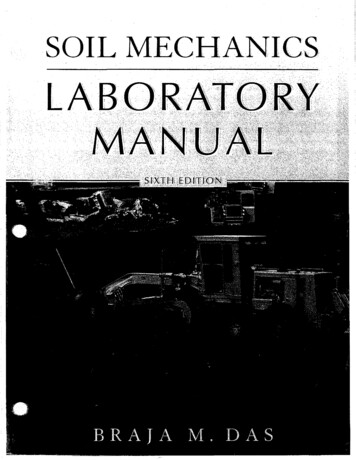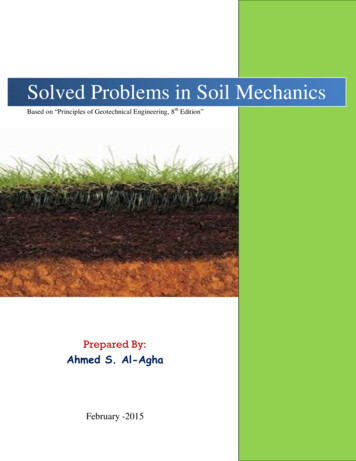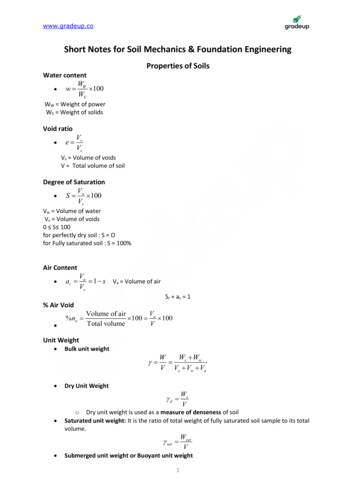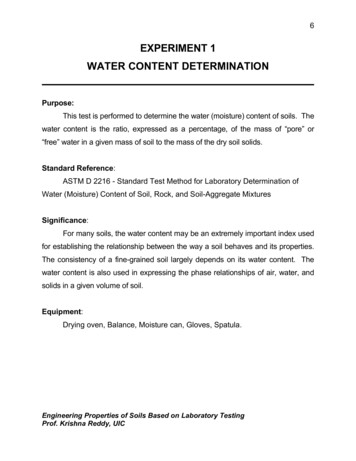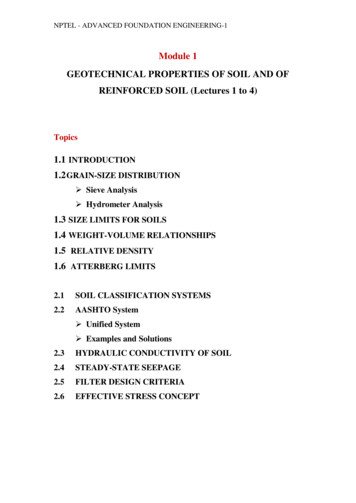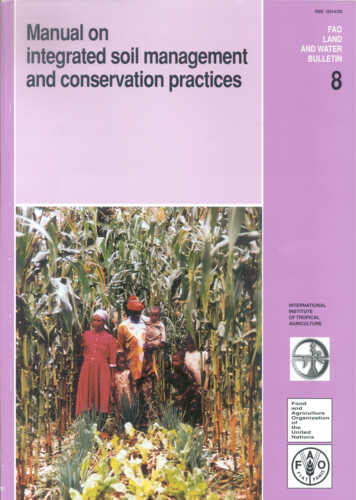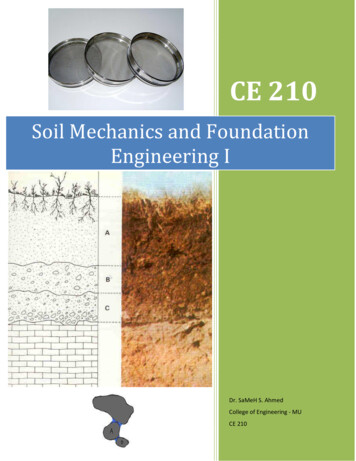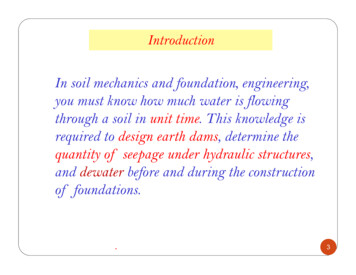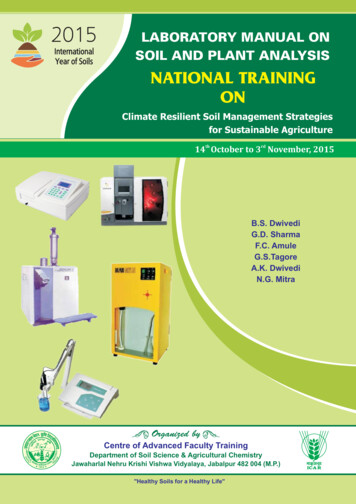
Transcription
LABORATORY MANUAL ONSOIL AND PLANT ANALYSISNATIONAL TRAININGONClimate Resilient Soil Management Strategiesfor Sustainable Agriculturethrd14 October to 3 November, 2015B.S. DwivediG.D. SharmaF.C. AmuleG.S.TagoreA.K. DwivediN.G. MitraOrganized byCentre of Advanced Faculty TrainingDepartment of Soil Science & Agricultural ChemistryJawaharlal Nehru Krishi Vishwa Vidyalaya, Jabalpur 482 004 (M.P.)"Healthy Soils for a Healthy Life"
CitationLaboratory Manual on Soil and Plant Analysis. 2015 (pp 50)National Training on Climate Resilient Soil Management Strategies forSustainable AgricultureCentre of Advanced Faculty TrainingDepartment of Soil Science and Agricultural ChemistryJawaharlal Nehru Krishi Vishwa Vidyalaya, Jabalpur 482 004 (M.P.)thrdheld during - 14 October to 3 November, 2015 2015, Jawaharlal Nehru Krishi Vishwa Vidyalaya, Jabalpur 482004 (M.P.), IndiaPublished byDirectorCentre of Advanced Faculty TrainingDepartment of Soil Science & Agricultural ChemistryJawaharlal Nehru Krishi Vishwa VidyalayaJabalpur 482 004 (M.P.), IndiaCompiled and Edited byDr. B.S. DwivediDr. G.D. SharmaMr. F.C. AmuleMr. G.S. TagoreDr. A.K. DwivediDr. N.G. MitraPrinted atFortune Graphics & Scanning CentreJabalpur 482 002 (M.P.), Ph.: 0761-4069025
Laboratory Manual on Soil and Plant AnalysisNational TrainingonClimate Resilient Soil Management Strategies forSustainable Agriculture(14th October to 3rd November, 2015)B. S. DwivediG.D. SharmaF.C. AmuleG.S. TagoreA.K. DwivediN.G. MitraSponsored byIndian Council of Agricultural ResearchOrganized byCentre of Advanced Faculty TrainingDepartment of Soil Science and Agricultural ChemistryJawaharlal Nehru Krishi VishwavidyalayaJabalpur–482004 (M.P.)
INDEXS.No.TitlePage No.1.Method of Collection of Soil and Plant Samples for Their Testing2.Profile Studies of Deep Black Soils (Vertisols)5-83.Creation of spatial variability maps of soil nutrient using geo-statistical tool9-104.Determination of pH and Electrical Conductivity in Soil Samples11-125.Determination of Organic Carbon Content in Soil6.Determination of Available Nitrogen in Soil14-157.Determination of Total Nitrogen in Soil and Plant Samples16-178.Determination of Phosphorous in Soil and Plant Samples18-199.Determination of Potassium in Soil and Plant Samples20-2110.Determination of Sulphur Content in Soil and Plant22-2311.Determination of Micronutrients in Soil and Plant Samples by AtomicAbsorption Spectrophotometer24-2612.Estimation of Boron in Soils, Plants and Water27-2813.Estimation of Microbial Biomass Carbon in Soil2914.Gamma Irradiation and its Importance for Food Preservation30-3415.Determination of Soil Aggregates35-3616.Determination of Bulk Density of Soil by Core Method3717.Estimation of Ascorbic Acid in Vegetables and Fruits3818.Estimation of Chlorophylls in Vegetables and Fruits3919.Estimation of Total Carotenoids in Vegetables and Fruits4020.Definitions4121.Preparation of Glassware4222.Appendix I to VI1-41343-50
Climate Resilient Soil Management Strategies for Sustainable Agriculture from14th October to 3rd November, 2015Method of Collection of Soil and Plant Samples for Their TestingB.S. DwivediDepartment of Soil Science and Agricultural ChemistryCollege of Agriculture, J.N.K.V.V., JabalpurTheinformation obtained from plant and soiltesting which reflect soil and plant healthrespectively is used for the exploitation of soil andpotential for obtaining maximum yield. Assessmentof a soils fertility status involves an estimation ofits available nutrient status i.e. the portion oramount of nutrient directly available in soil forsubsequent uptake by crop plant. The causes ofsuccess or failure of this testing are varied usuallyrelated to the quality and amount of research dataavailable for calibration, interpretation andrecommendations. With reference to this, testingrefers to any physical or chemical measurementmade on soil/plant. The meaning may be restrictedin the sense that it implies rapid chemical analysisused to assess the (available) nutrient status ofsoil/plant or the meaning may be broader due to usein evaluation interpretation and recommendations.Acceptance of this testing is strongly dependentupon the accuracy with which these tests can beused in solving the localized problems related tocrop response and fertilizer use.Nutrient status of soil and plant acts as abarometer of their health. This can be evaluated inseveral different ways each having its pros andcons. But the accepted methods include soil testingand plant testing.Why soil testing ? Soils fertility status assessment involves anestimation of its available nutrient status It gives the amount of nutrient directlyavailable in soil for subsequent uptake by cropplant. Guides to arriveapplication ratio. It is a method of evaluating nutrient status(physico-chemical properties) of the soil i.e.the assessment of the fertility of the soil todetermine nutrient deficiencies.atoptimumSubsequently giving recommendation fortheir correction (Lime/Gypsum requirementetc.)(iv) To predict the probability of gettingmaximum response of crops to fertilizers.Objectives of soil testing: To study/ maintain fertility status of a field. To predict the probability of obtaining aprofitable response of lime & fertilizers. To provide basis for recommendation offertilizers. tryfordevelopedofplansforresearchandeducationwork. To study the acidity, alkalinity and salinityproblems. To determine the suitability of the soil forlaying gardens. Lime problems. Soil survey.Apparatus and materials: Khurpi Spade Augers Plastic bowl Scale Rack Wooden roller Mortar-pestle Sieve Polythene/paper/cloth bags Labels Card board cartons Aluminium boxesfertilizerScrew Auger It is also concerned with environmental qualityfor the community hazards.Objectives(i)To evaluate soil fertility and its productivityby the estimation of level of nutrient (Low,Medium, High).(ii) Grouping of soil for their classification(iii) To determine the specific soil problem suchas an acidity, alkalinity and sodicity if exist.Jawaharlal Nehru Krishi Vishwa Vidyalaya, Jabalpur – 482004 (M.P.)Tube Auger“Healthy Soils for a Healthy Life”1
Climate Resilient Soil Management Strategies for Sustainable Agriculture from14th October to 3rd November, 2015To meet objective of soil testing is divided into 4phases:1. Collection of soil samples2. Extraction and determination of the availablenutrients3. Interpretation of analytical results4. Providing recommendation5. Follow up of results and evaluation of therecommendations madeProcedure for soil testingThe procedure for testing the soil to meetthese objectives are divided into the followingphases:(i)Collection of soil samples and itspreparation(ii) Extraction and determination of nutrientsand physico-chemical properties of the soil.(iii) Interpretation of analytical results(iv) Recommendation and follow up of resultsand evaluation of recommendations.Collection of soil samplesSince soil is a very heterogeneous massand the greatest source of error is usually soilsamples itself hence, the soil sample collectedshould be representative of the area sampled andshould also be uniform. Variations in slope,texture, colour, crops grown, and managementlevels must be taken in to account. Recentlyfertilized plot, bunds and channel, spot near tree,wells, compost pits and other non-representativelocations must be avoided while sampling. Whencrops are planted in rows, samples can be drawn inbetween the lines. The sample should be taken in azig-zag manner. A representative composite soilsamples can be composed of 8 to 20 sub samplesfrom a uniform field (Jones 1988). A common errorin soil sampling occurs when the top few cm of soilare dry and are not included in the normal sample.Hence, the value of soil test depends on how wellthe sample represents a field.A variety of factors such as depth ofsampling, number of cores of composite sample,season, crop etc. influence the collection of soilsamples. For field crops a sampling depth upto 1530 is desired while, 10 cm depth is normallysufficient for sampling for the pasture crops (Rao,1995). For deep rooted crops, horticultural crops orunder dry farming conditions sample from variousdepths may be preferred. For immobile nutrient,testing of sample to tillage depth may givesatisfactory results but for testing of mobilenutrients (NO 3-, Cl-, SO4-- etc.) sample should betaken to a depth of 60 cm. In saline alkali soils, saltcrust (visible) on the top soil surface should betaken separately along with the depth of samplingrecorded. Under intensified cultivation samplingshould be done every year at the same time. Forsampling of soft and moist soil, the tube auger,spades, or khurpi is quite satisfactory for sampling.A screw type auger is more convenient on hard/drysoil while, post whole auger is useful for samplingexcessive wet or rice field. If spade or khurpi isused a V shaped cut may first be made up to theplough layer. A uniform 15 cm thick slice takenout. Auger are generally useful for deep profilesampling.How to take representative soil sample1. Divide the field into separate units dependingon variation in slope, colour, texture, cropgrowth and management.2. Remove the debris, rocks, gravels etc from thesurface before collecting soil sample.3. Make a V shape cut into the soil to a depth ofsampling (0-15 cm) and obtain 2 to 3 cm thickvertical slices along the depth.4. Collect 10-15 samples randomly in zig-zagmanner from each field.5. Mix samples by quartering method andapproximate 500 g of sample is retained.6. The sample must be kept in a clear cloth orpolythene bag.7. Label it with suitable description andidentification marks.8. Send the soil samples to soil testing laboratoryalong with the information sheet.Information sheet : The soil sample thus collectedmust be furnished important information like –1. Sample number2. Name and address of the farmers.3. Details of the field and site. Local namefield,Khasra no etc.4. Date of sampling5. Name of crop and variety to be sown6. Source of irrigation7. Whether the crop in the subsequent season willbe irrigated or un-irrigated.8. Name of crops and fertilizer used in previousyears.9. Date of harvest of the previous crop.10. Any other problem observed in the field.Jawaharlal Nehru Krishi Vishwa Vidyalaya, Jabalpur – 482004 (M.P.)DIVISION OF AREA“Healthy Soils for a Healthy Life”2
Climate Resilient Soil Management Strategies for Sustainable Agriculture from14th October to 3rd November, 2015SELECTION OF SAMPLING POINTSPreparation of soil sample for testing1. Spread sample for drying on clean cloth,plastic or brown paper sheet.2. Remove the stone pieces, roots, leaves & otherun-decomposed organic residues from thesamples.3. Large lumps of moist soils should be broken.4. After air drying the samples should be crushedgently and sieved through a 2 mm sieve.5. About 250 g of sieved sample should be keptin properly labeled sample bag for testing.Appropriate time for soil samplingAn ideal time for soil sampling is just afterharvest of the rabi crops,Precautions to be taken during collection of soilsampling1. Remove all debris from surface beforecollection of soil sample.2. Avoid taking sample from upland and low landareas in the same field.3. Take separate sample from the areas ofdifferent appearances.4. In row crop take sample in between rows.5. Keep the sample in a clean bag.6. A sample should not be taken from large area(more than 1-2 ha).7. Sample for micronutrient analysis must becollected by steel or rust free khurpi/auger andkept in clean polythene bag.Plant analysisPlant analysis is used as a diagnostictechnique to determine the nutritional status ofplants and fertilizer needs. Mineral composition ofplant is influenced by many factors which are alsoto be considered. Fundamental advances inquantitative studies at relationship between nutrientand crop yield have been attempted. In oldermethods of analysis the quantities of minerals inthe manure plant were determined but under thenewer concept of analysis only functionallyassimilating portion of plant is analyzed. Hence,sampling of the assimilatory portion of the plant isimportant.Plant samplingThe particular method to be used will depend uponthe kinds of plants to be sampled determinations tobe made and over all objectives.i) Take enough individual plant or plant parts toovercome the factor of plant variability.ii) If correlation with soils are to be made makesampling distribution representative of a givensoil area.iii) Collected samples should be cleared to avoidcontamination from fumes or decomposition.iv) Suitable methods should be employed forgrinding.If testing is to be done for conformingdeficiency/ toxicity as displayed by visualsymptoms then 100 to 200 leaves showingparticular visual symptoms should be collected.If the testing is to be used for continuedfertilizer guidance then sampling should be done bydividing the whole area into units and thencollecting the samples from each unit. Units maybe selected on the basis of slope, texture, depth andcolour of soil etc. in case of orchards at least 20%of the trees should be sampled. Seven to 10 monthsold spring cycle leaves be selected. Those leavesshould be so selected so that they represent averagefoliar condition.In fact plant sampling can be modifieddepending upon the purpose for which the sampleis required. In studying the influence of factors asthe stage of growth, cultural practices, manurialtreatment or grazing on mineral composition of acrop of pasture whole above ground part of theplant from selected areas will be required. Whencomposition of different species of plants growingon various soil types is needed, the material sampleshould be restricted to pure species at comparablestage of growth. To study the effect on nutrientuptake the desired investigations of soil types plantshould be taken from a small area typical of the soiltype and a composite soil sample should also becollected to represent the same area.Interpretation of the resultsResults of foliar diagnosis must beconfirmed by plant analysis and concentration ofnutrient in the soil. It will give general relationshipbetween growth and quantity of the nutrientabsorbed.Percentage of an element in the plantalone cannot be taken as the basis of judging thedeficiency/sufficiency of the element. However, ifit is used then physiological age of the leaf must beJawaharlal Nehru Krishi Vishwa Vidyalaya, Jabalpur – 482004 (M.P.)“Healthy Soils for a Healthy Life”3
Climate Resilient Soil Management Strategies for Sustainable Agriculture from14th October to 3rd November, 2015taken into consideration. Sometimes the percentageof an element in the plant is to be judged vis-à-visthe percentage of other elements i.e. ratios of theelements are used.However, the information about thepercentage of nutrient in the plant based onconsiderable amount of experimentation can beused to define the critical level (Cate and Nelson,1965) i.e. percentage of an element in the plantbelow which the application of the element inmineral fertilizer form is likely to increase theyield. Moller (1970) have suggested the diagnosisand control of the nutritional disorders increasebased on inorganic tissue tests.References Cate, R.J. and Nelson, L.A. (1965).Int. Soiltesting series Tech. Bull.No. 1 North CarolinaState Univ. USA. Chapman, H.D. and Pratt, P.F. (1961).Methodsof analysis for soils, plants and waters. Univ.of California, 56-65. Moller, N.J. (1987). Recent advances in plantnutrient. Vol.I Am. Soc. Agron. MadisonWisconsin, 63-73. Walsh, L.M. and Beaton, J.D. (1973).Soiltesting and plant analysis. Soil Sci. Soc. Am.Proc. 3-23. Jones, J.B., (1988). Soil Testing and PlantAnalysis.Procedure and use. Tech. Bull. 109.Food &Fert. Tech. Centre, Taipci city, pp. 14. Rao, S. (1995).Analysis of soil for availablemajor nutrients methods of anlaysis of soil,plant water and fertilizers. Ed. HLS Tondon,Fert. Dev. Cons. Org. : 13-35.Jawaharlal Nehru Krishi Vishwa Vidyalaya, Jabalpur – 482004 (M.P.)“Healthy Soils for a Healthy Life”4
Climate Resilient Soil Management Strategies for Sustainable Agriculture from14th October to 3rd November, 2015Profile Studies of Deep Black Soils (Vertisols)G.P. GuptaDepartment of Soil Science and Agricultural ChemistryCollege of Agriculture, J.N.K.V.V., JabalpurVertisoils or deep black soils occur globally undervarious parent materials and environmentalconditions (Table 1).Table 1. Distribution of Vertisols and associatedsoilsArea(m ha)%ofGrossBlacksoils105.038.7Asia & far East(Mainly India)70.325.9Australia48.817.7Latin America27.09.9North ear & Middle CHAD15.55.7China11.64.3Others( in Entisols4.219.8Alfisols0.41.9TOTAL21.2100They clayey soils that shrink and swellextensively upon changing soil moistureconditions. Vertisols exhibit unique morphologicalproperties such as the presence of slickensides,wedge-shaped aggregates, diapir (mukara), andgilgai. Shrink-swell phenomena are the dominantpedogenic processes in Vertisols and are attributedto changes in interparticle and intraparticleporosity with changes in moisture content.Definition of Vertisols :Taxonomically for defining Vertisols,there must be1. A layer 25 cm or more thick with an upperboundary within 100 cm of the mineral soilsurface, that has either SLICKENSIDES orWEDGE SHAPED PEDS that have their longaxes tilted 10 to 60o from the horizontal; and2. A weighted average of 30 % or more clay infine earth fraction either between the mineralsoil surface and a depth of 18 cm or in Aphorizon, whichever is thicker and3. 30 % or more clay in fine earth fraction of allhorizons between a depth of 18 cm and eithera depth of 50 cm or a densic, lithic orparalithic contact, a duripan, or a petrocalcichorizon if shallower and4. Cracks that open and close periodically.Vertisols are significant global resourcesthat serve as the lifeline in subsistence agriculturedue to their high ful utilization are imperative for continuedproductivity and long term sustainability of theseresources for current and future civilizations.Morphology of a soil is best evaluated from the insitu examination of the soil profile. A recently dugpit large enough for observation of a pedon isdesirable. Old exposures such as road banks andditches are acceptable only for preliminary studiesbecause morphological features often becomealtered after prolong exposure.Jawaharlal Nehru Krishi Vishwa Vidyalaya, Jabalpur – 482004 (M.P.)“Healthy Soils for a Healthy Life”5
Climate Resilient Soil Management Strategies for Sustainable Agriculture from14th October to 3rd November, 2015Normally the size of profile pit is kept 1.8m long, 1.2 m wide and 1.8 m deep but for the studyof black soils, the width of pit varies from place toplace depending on its cyclic wave length of puffsand shelves. It should be kept in mind that at leasthalf wave length covering both, puff and shelve isconsidered while exposing profile pit in order tostudy the pattern of cracks and slickensidesperfectly.The profile examination begins with a firstapproximation and marking of soil horizonboundaries on the profile. Each horizon is thencarefully observed and described. Horizonboundaries are relocated as required by the detailedstudy (Buol et al. 1998). Th description sheetcontaining the columns of site and soilcharacteristics is filled up by the profile study groupduring pedon studies.Vertisols are relatively homogneous intheir morphology. Although horizonation is notdistinct yet a few horizons above the parent materialmay be identified as self mulching surface (Ap),blocky subsurface (A12), slickensided horizon andwedge shaped subsoil (Bss).The depth of these soils may vary fromshallow to very deep. Previously the black soilswere grouped as shallow ( 30 cm) medium (30-100cm) and deep ( 100 cm) but later on Sehgal (2008)modified the depth of shallow soil as less than 50cm.Requirement of Vertisols :Main requirements of Vertisols are thepresence of high content of clay ( 30 %) andpredominance of montmorillonite (2:1 expandingclay). Other important parameters for thedevelopment of Vertisols are:(i) Parent material having basalt, argillaceouslimestone, marine clays and shale(ii) Weathering period must be extensive for thedevelopment of solum with 2:1 expandingclays(iii) Weathering environment should be such thatno further weathering of 2:1 expanding claystakes place. Even no inter-layering exists to theextent the properties are destroyed(iv) Sequence of events should continue likechurning/mixing, development of argillipedoturbation, development of slickensides andformation of wedge shaped structuresPedogenesis of Vertisols :1. Separation of blocks : Deep wide cracksseparate the soil into strong and massive prismlike blocks in the upper part of the pedon thatbreak into angular blocky peds of hard and firmconsistence.(a) Cracking of soil : During dry season, the soilcracks to the surface due to shrinkage of 2:1expanding clays that may extend to a depth of1 metre or more.(b) Falling of surface soil material : Whilecracks are open, surface soil material fallsinto them by several mechanisms such asanimal activity, wind or at the onset of rainyseason by water.2. Hydration of clays : The clay hydrate and dueto their high coefficient of expansion andcontraction, expand 3 dimensionally on wetting.(a) Expansion of clays : Cracks close on thesurface but because of the extra material nowpresent in the lower part of the profile, agreater volume is attained and the expandingmaterial presses and slides the aggregatesagainst each other, developing a "lentil"angular blocky structure with slickensidefeatures on the pad surfaces.(b) Shear stress development: The slippingoccurs where shear strength is surpassed byshear stress acting upon a soil mass. The shearstress is a major force caused by swelling anddevelops when volume expansion resultsduring the wet cycle.(c) Formation of slickensides: The slickensides,intersecting or close enough to intersect, alsoresult in wedge shaped structural aggregates,the most characteristics feature of Vertisolswhich develop with their longitudinal axesinclined at 30 to 60 from horizontal (Sehgaland Bhattacharjee, 1988).(d) Buckeling of land space: This expansionbuckles the land scape, forming the microrelief called gilgai. The micro basins containmore organic matter than the micro ridges andprobably it results from admixtures ofsubsurface material into micro ridge area andslight erosion of organic rich fines from theridges to the basins.3. Incomplete leaching : In most shrink swellsoils, the temperature being high, the potentialJawaharlal Nehru Krishi Vishwa Vidyalaya, Jabalpur – 482004 (M.P.)“Healthy Soils for a Healthy Life”6
Climate Resilient Soil Management Strategies for Sustainable Agriculture from14th October to 3rd November, 2015evapotranspirationsuggestingincompleteleaching and inducing the process ofcalcification in these soils.Cyclic movement of soil material :4. Thickness of horizon : Thickness of A1 inVertisols varies with the linear frequencies ofpuffs and shelves of gilgai micro relief.5. Horizon boundary (Amplitude): It is theAmongst several processes acting in thedifference between vertical distance from theformation of Vertisols, the predominant processsurface of pedon to the lower boundary of crestseems to be haploidization i.e. mixing by argilliof cycle and the lowest point of trough of cyclepedoturbation. The specific features of such soilsin same pedon. The amplitudes are grouped asare :low, medium of high according to the vertical1. Gilgai micro relief : The term gilgai is andistance as below 25, 25 to 75 or above 75 cm,Australian aboriginal term meaning small waterrespectively. Shape of apparent topography ofhole.the intermittent horizon is also graded asPedogenic micro topographical featurestongued (vertical extent horizontal distance),like puffs (microknolls) and shelves (micro basins)wavydevelop that remain intimately associated with onehorizontal distance) and smooth (verticalanother (Bhattacharjee et al. 1977), Columbe et al.extent horizontal distances) as suggested by(1996) introduced a term "diapir" meaning aBartelli calextentapproximatingtheAge of Vertisols :penetrates to the overlying horizons and approachesIt is difficult to assign the Vertisols aor reaches the surface. If diapir and gilgai occur, theplacemound in gilgai is always developed over the diapir.classification as there are greater differences ofHallsworth and Beckman (1969) classified gilgaiopinion whether they are old, young or remaininto 6 types i.e. normal or round, melon hole,inthegeneticschemeofsoilin equilibrium with the environment.Lattice, Linear or wavy, tank or stony but later on1. Views as Vertisols are old : The end productPaton (1974) suggested only two types of gilgai i.e.of a development sequence involves the soilslinear and circular (Nuram or Pockmarked) each ofwhose B horizon has become so clayey thatwhich were grouped into 4 types.α type - Mound and depression equally developedshrink-swell cycles developed and eventually(No shelf present)β type - Mound of much greater extent thanbecause high content of fine clay and highdepression (No shelf present)γ type - Depression of much greater extent thanlarge scale."swallowed" the A horizon. It is possiblefc/cc ratio may be produced by lessivage on a2. Views as Vertisols are young : Thefateofmound (No shelf present)δ type - Mound, shelf and depression all presentVertisol may be to undergo alteration of 2:12. Size of cyclic pedons : Half cycle linear distanceprofile would then cease to churn and(HCLD) measures the lateral dimension of aeluviation process would dominate. Thiscyclic pedon. It may be small, medium or largeinterpretation suggests that Vertisols arei.e. below 1, 1 to 2 or above 2 to 3.5 meter,relatively young soils.respectively.clays to non expanding type of clay. The3. View as Vertisols are in equilibrium :3. Horizon sequence : In Vertisols, the horizonVertisols remain in equilibrium with theirsequence has been suggested to be A1-Bss-BC-environment and that the 2:1 expanding latticeC where "ss" indicates about the presence ofclays are stable and will persist, barring idered diagnostic of environments inJawaharlal Nehru Krishi Vishwa Vidyalaya, Jabalpur – 482004 (M.P.)“Healthy Soils for a Healthy Life”7
Climate Resilient Soil Management Strategies for Sustainable Agriculture from14th October to 3rd November, 2015which the parent material is basic and gives riseunder the influence of wet dry climate.to the formation of 2:1 expanding lattice silicatesTable 2 : Range in characteristics of Vertisols and Vertic InceptisolsHorizonSoil colourTextureStructureSpecial features(10 YR)Width ofcracks (cm)A. Typic Haplustert (10 YR - 2.5 YR)Ap/A114/2, 3/3, 3/2, 3/1C1f/1m sbk1c/2c pr-3c pr2-5A123/3, 3/2, 3/1C2m/2c abk2c pr - 3c pr2-5Bss3/3, 3,2, 3/1, 2/1C2m/3c abkIntersecting lickensides*1-2BC4/4, 3/4C2m/2c abk----do----0.5-1C5/4, 4/4, 4/3c-gc2msbk/ massive--Ap/A5/2, 4/3, 4/2, 3/2Clgr/1m sbk1c pr-2c pr2-2.5AB4/3, 3/3cl-c1m/2m sbk----do----2-2.5B214/3, 3/3, 3/2cl-c2m sbk-3m/3c2c pr - 3c pr or pressurefaces/abk slickensides1.5B226/3, 5/3, 4/4, 4/3gscl-cl----do------C7/6, 6/3, 5/3, 4/4gsl-gscl1f sbk/ massive--B. Vertic Haplustept (10 YR - 7.5 YR)*or parallelepipeds with long axes tilted from 35 to 55 from horizontalReferences: Bartelli, L.J. (1971). Soil taxonomy, correlationand Interpretation. Proceedings of Workshoporganized by All India Soil and Land UseSurvey, New Delhi. Bhattacharjee, J.C., Landey, R.J. and Kalbande,A.R. (1977). A new approach in the study ofVertisol morphology. J. Indian Soc. Soil Sci. 25: 221-232. Buol, S.W., Hole, F.D., McCracken, R.J. andSouthard R.J. (1998). Soil Genesis andclassification. Panima Publication Corporation,New Delhi. Coulombe, C.E., Wilding, L.P. and Dixon, J.B.(1996).AnOverviewofVertisols:Characteristics and Impact on Society. Adv.Agron. 57 : 289-375.Jawaharlal Nehru Krishi Vishwa Vidyalaya, Jabalpur – 482004 (M.P.) Paton, T.R. (1974). Origin and terminology forgilgai in Australia. Geoderma. 11 : 221-242. Sehgal, J. (2008) Pedology – concepts andapplication, 2nd edition Kalyani Publication,Ludhiana P. 416. Sehgal, J., and Bhattacharjee, J.C. (1988).Typical Vertisol of India and Iraq-theircharacterization and classification. Pedologie.38 : 67-95. Sehgal, J., Saxena, R.K. and Vadivelu, S.(1987). Field Manual for Soil ResourceMapping of different states. NBSS & LUP,Nagpur, pp. 73. Soil Survey Staff (1999). Keys to SoilTaxonomy. 9th Ed. CSC, SMSS, United StatesDepartmentofAgriculture(USDA)Washington, D.C.“Healthy Soils for a Healthy Life”8
Climate Resilient Soil Management Strategies for Sustainable Agriculture from14th October to 3rd November, 2015Creation of spatial variability maps of soil nutrient using geo-statistical toolG. S. TagoreDepartment of Soil Science and Agricultural ChemistryCollege of Agriculture, J.N.K.V.V., JabalpurSoil fertility, a dynamic natural property, fluctuatesthroughout the growing season of each year due toalteration in the quantity and availability of nutrientsby the addition of fertilizers, manure and compost.Due to the bulkiness, weight and lack oftechnologies to apply manure, it is restricted tofields near the settlements. This always causes overor under application of the required plant nutrientsand therefore, creates a nutrient gradient across thecultivated lands and leads to other undesirableenvironmental im
Climate Resilient Soil Management Strategies for Sustainable Agriculture from14th October to 3rd November, 2015 Jawaharlal Nehru Krishi Vishwa Vidyalaya, Jabalpur – 482004 (M.P.) “ HealthySoils for a Life” 1 Method

